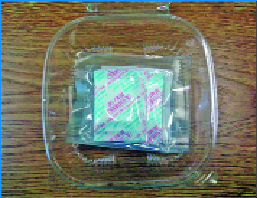
This clamshell was designed by Dr. Jinhe Bai at Oregon State University to reduce moisture loss in cherries and extend their shelf life. A packet of ethanol powder could help reduce decay.
An Oregon State University researcher has devised a clamshell container that he believes can double the storage life of cherries. Dr. Jinhe Bai at the Mid-Columbia Agricultural Research and Extension Center in Hood River said fruits, including cherries, are sensitive to water loss, and the type of clamshell container used for cherries has large openings through which moisture is lost.
Loss of moisture results in loss of weight and quality, and limits the shelf life of the cherries, he said. It can affect the firmness, color, and luster of the cherries and the color of the stems. Cherry stems that are mostly brown or dry are unacceptable. Bai has designed a new clamshell package that fastens tightly, but has air holes in it. A package that is too airtight would prevent the flow of oxygen.
Humidity
In tests last year, he showed that Regina cherries in his new package were of better quality after six weeks than cherries held for only three weeks in the commercial clamshell. Although humidity was higher inside the packages he designed, the amount of decay was similar to the amount in the commercial clam shell, he said.
This year, he will do more detailed tests to assess the quality of the cherries and humidity levels inside the packages. He has applied for a patent for the new clamshell and hopes it can be commercialized soon. Wal-Mart is interested in using it. Bai is also exploring the idea of placing a package containing a low dose of ethanol powder inside the clamshell to control bacteria and molds. The package releases ethanol very slowly for two to four weeks.
Japan
He thinks there might be resistance to ethanol packets on the domestic market, but said they are already in use in Japan, though for other types of foods such as cakes. He sees potential for using them in cherries exported to Japan, which is a major market for U.S. cherries.




Leave A Comment